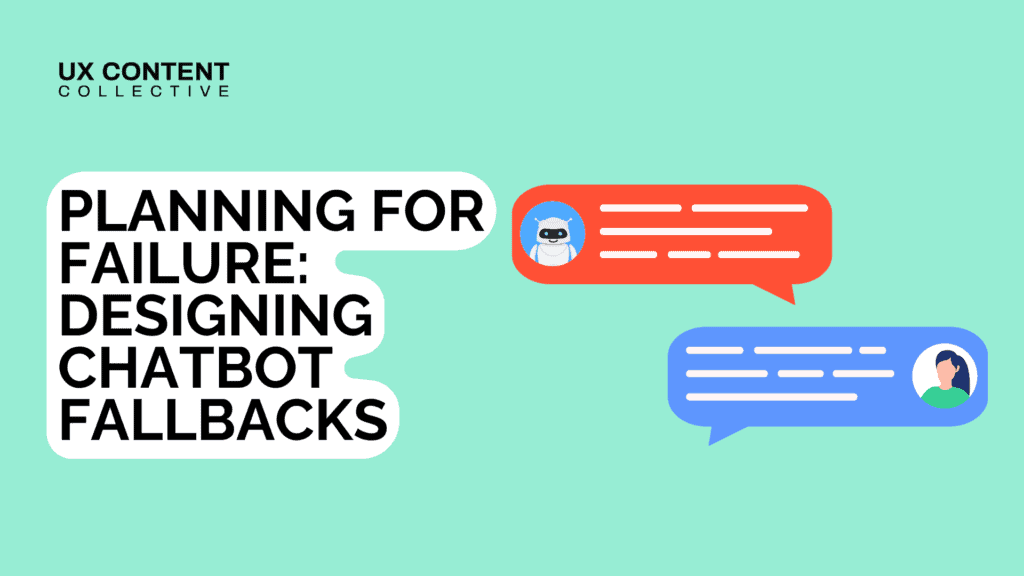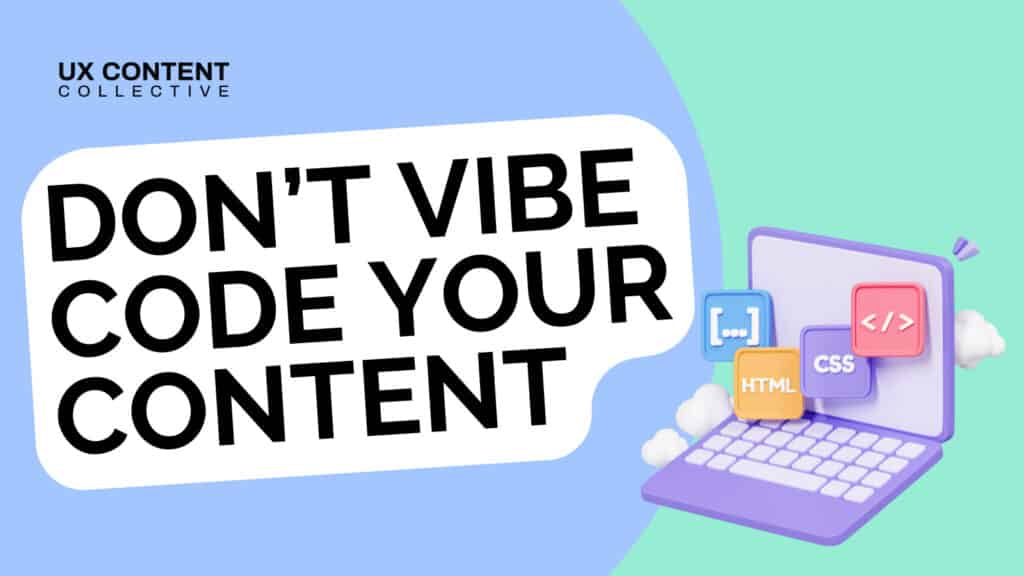
Don’t vibe code your content design
Patrick Stafford

Interested in UX writing and content design?
Explore our content design and UX writing training:

Vibe coding! Silly name – cool concept. If you’re unfamiliar, the term refers to the idea that now it’s become extremely easy to create full-blown desktop and mobile applications with just a few AI tools like Cursor or Framer.
Twitter (I refuse to call it X) and LinkedIn are filled with people making apps with very little coding knowledge. Some of them cool and useful, others are a bit of a mess. But it’s encouraging and fascinating to see a movement towards natural language-based instructions for code rather than relying on intense knowledge of syntax.
In short: if you can describe it, a tool can code it for you.
But of course, things aren’t always what they seem. Vibe coding has its downsides, and I fear the new wave of app creators might find themselves with similar problems if they try to use the same approach with content.
The ups and downs of vibe coding
There are already a bunch of “vibe coding” examples showing up like these games and apps:



Fun, right? Yes, absolutely. It’s fun to be able to just think of something and then create it – so these tools are doing for code what Canva, Figma, and others have done for design.
But as people who have worked in product teams will know, the best code isn’t just the code that creates the application. The best is the most efficient version that avoids repetitive functions or just takes less time or memory. Good developers know this, and it’s why warnings against vibe coding have started popping up too:

 You get the idea.
You get the idea.
As it turns out, when you start creating applications with pure vibes and intend for an audience of more than yourself, things can turn bad quickly. The problem is that vibe coding to create a working application is an illusion, masking the terrible structure below it. You can have the most beautiful house imaginable, but it doesn’t matter if the structure is built on sand:

Vibe coding is fun, fast, and often beautiful. It’s a creative playground, a way to prototype quickly, test ideas, or sketch the feel of an experience without getting too bogged down in structure or systems.
But it skips the hard parts. You haven’t spoken to users, you haven’t researched the types of tasks they might want, and from a technical standpoint you’re opening yourself up to attacks or costly API calls if you don’t know what you’re looking at.
Tech debt is easy to ignore if things look like they’re working. Content debt isn’t.
Content debt is real and it piles up fast
Just like tech debt, content debt is the cost of moving fast without a plan. When you generate placeholder content or fill a product with AI-generated microcopy that hasn’t been reviewed or structured, you’re taking out a loan against your users’ experiences.
Eventually, someone has to pay it back. That might look like:
- Confusing flows that need a full rewrite
- Voice inconsistencies across pages or touchpoints
- Poor accessibility or localization
- Mismatched mental models that frustrate users
- Hours of content cleanup and system mapping later on
And if no one pays it back? Your shiny, fast-built product becomes a confusing, brittle mess.
Let’s say you’re building a journaling app with AI-generated writing prompts. On the homepage, you label new entries as “Reflections.” But when the user taps to create one, the button says “New Thought.” And when they view past entries, the heading reads “Notes.”
Technically, nothing’s broken. But users might wonder:
- Are these all the same thing?
- Is there a difference between a “Reflection” and a “Note”?
- What happens if I delete a “Thought”?
Confusion like this adds up fast. And then add in inadvertent mistakes like forgetting to capitalize the “T” in “New Thought” on a separate screen. The act of capitalization turns the word into an Important Thing That Needs Attention. Through just a simple error, you’re causing users to stop, think harder about using your product…and that second might be all it takes to stop using it.
You don’t need a full-on taxonomy. Just pick a term and stick with it. If you’re unsure, try writing a sentence that explains the action, like:
“Start a new reflection to capture your thoughts.”
If it doesn’t sound right, pick something else. Just stay consistent.
Content design matters when AI is involved
AI can accelerate our work. But it still needs constraints, intent, and evaluation criteria.
Here are some ways to bring intentionality into AI-assisted product creation:
1. Define your terminology
Set up a simple content glossary early on. Decide how you’ll refer to key actions, objects, and system states. This helps your AI tools stay consistent, and your users stay oriented.
Call it a “note” on one screen and a “thought” on another? That’s a recipe for confusion. Decide on your core terms early (like what you call your users’ main actions, objects, or outcomes), and stick with them throughout the app.
This makes your interface feel more polished and makes it way easier to explain what your product does.
2. Structure before you generate
Don’t prompt a chatbot to “write onboarding copy” before you’ve mapped the onboarding journey. Figure out what the user needs to know, in what order, and what action they should take at each step. Then use AI to help fill in the blanks after the structure is sound.
It’s easy to let AI write all your microcopy: “Generate error messages for failed logins.” “Write an onboarding screen for my task app.”
But before you prompt, ask yourself:
- What does the user need to do at this step?
- What do they need to understand in order to do it?
- What could confuse or block them?
Let the answers guide your prompts, and you’ll get way better content, plus a smoother experience for your users.
3. Set evaluation criteria
Before you start reviewing AI-generated content, define what good looks like. Is it clear? On-brand? Actionable? Inclusive? Evaluation criteria help you avoid the “well, it sounds fine” trap and keep your team aligned.
4. Test the flow by reading, not clicking
Try this: Instead of clicking through your prototype, read every screen out loud like a script. Do the steps make sense? Do the terms match up? Is it clear what happens next? If you get lost or confused while reading, your users probably will too.
5. Set a “vibe check” for clarity
Yes, your app should feel cool, but cool isn’t the same as clear. Before you ship, do a quick clarity check:
- Is the main purpose obvious?
- Are the actions labeled clearly?
- Do error messages actually help users fix the problem?
- Would someone who just found your app know what it does?
Great vibes + great clarity = trust
6. Avoid content debt
Placeholder text and random AI blurbs might work for a demo but they stack up over time. That’s content debt. And just like tech debt, it gets harder to fix the more you build on top of it.
You don’t need to write everything perfectly upfront. But check in now and then: Are you still guiding the user? Are things still clear? Is the experience still coherent?
A little cleanup now can save a major rewrite later.
Vibe code away – just be careful of content
As AI tools become more embedded in design and product workflows, content has an even more important role to play: shaping the intent, structure, and evaluation of content at scale.
So, embrace the vibes. Just be careful while you do it.



